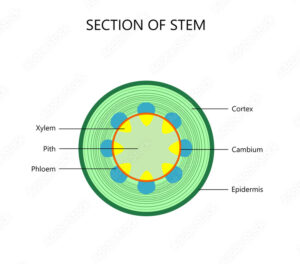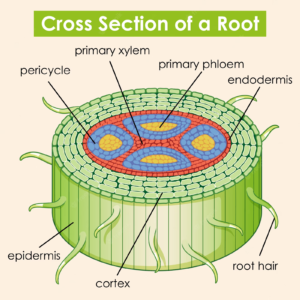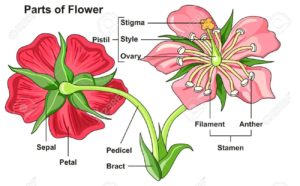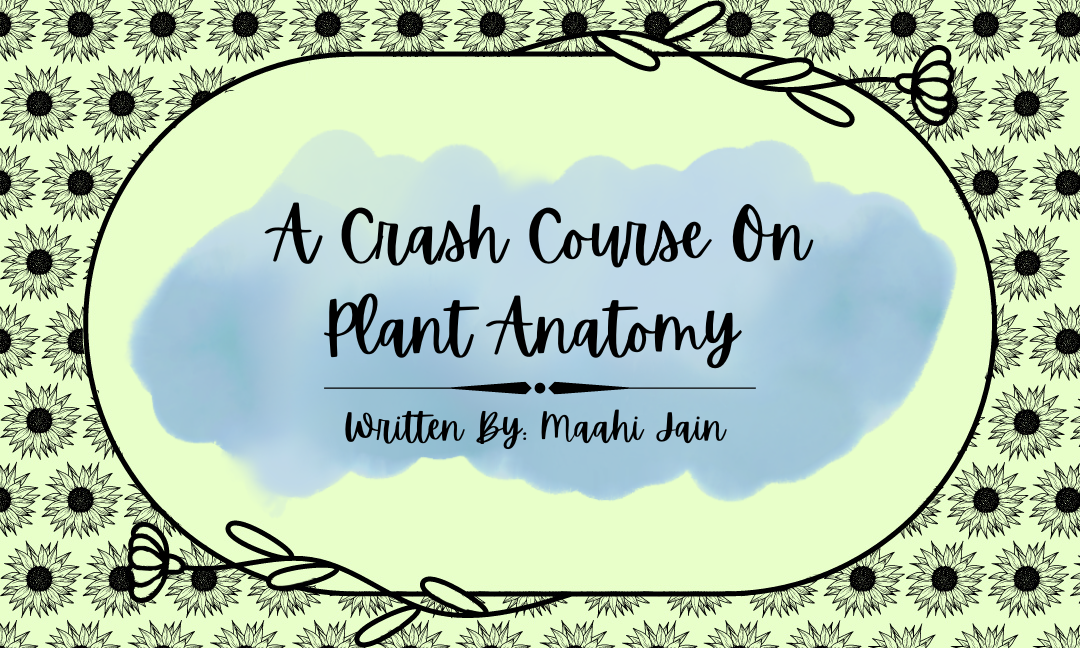Written by: Maahi Jain
Edited by: Advita G.
Designed by: Tvisha Lakhani
Published by: Kiritika Rana
Whether we’re aware of it or not, we’re already familiarized with the basic anatomical parts that give a plant its distinct characteristics, may that be its striking green pigment, or its long stem. Scientists and nature enthusiasts alike made qualitative observations, and it was these simple observations that led to more in-depth study on the anatomy and functions of a typical plant. Knowing even just the rudiments of plant anatomy is vital to our understanding of the huge role they play in ecosystems!
Leaves
 As toddlers, we always drew a long line for the stem, and pointed ovals for the leaves—or was that just me? Regardless, this is a fairly accurate representation of what stems and leaves look like. However, leaves aren’t subject to sharp-tipped ellipses. They can be needles, like those of conifers, or have grooves, like ferns. No matter what shape the exterior may be, the interior structure of any leaf remains similar. They consist of three key tissues—the epidermis, the mesophyll, and the vascular tissue.
As toddlers, we always drew a long line for the stem, and pointed ovals for the leaves—or was that just me? Regardless, this is a fairly accurate representation of what stems and leaves look like. However, leaves aren’t subject to sharp-tipped ellipses. They can be needles, like those of conifers, or have grooves, like ferns. No matter what shape the exterior may be, the interior structure of any leaf remains similar. They consist of three key tissues—the epidermis, the mesophyll, and the vascular tissue.
The outside of the leaf is covered in the epidermis. The layer secretes a waxy substance called the cuticle. This cuticle prevents moisture loss, instead retaining it. The epidermis houses guard cells, regulating gas diffusion and exchange between the plant and environment. This is done by controlling the opening and closing of stomata, releasing or withholding gases such as carbon dioxide and oxygen.
The next tissue is the mesophyll, located in the middle. Mesophyll is made up of two types—the palisade, and the spongy mesophyll. The palisade mesophyll has rectangular shaped cells with gaps in between. It is the site where most of the photosynthesis process takes place. Chloroplasts—what gives a plant its green colour—can be found in this region, too. They take in the sun’s energy and transform it into chemical energy. The spongy mesophyll—in contrast to the palisade mesophyll’s consistent rectangular shape—are irregular. They help out with the gas exchange.
The last tissue is the vascular tissue. This tissue contains something called the xylem and phloem. While the xylem transports water and minerals throughout the plant, phloem transports nutrients like sugar.
Stem
Although it may seem at first that the stem doesn’t serve much of a purpose, going into the anatomy proves otherwise. The stem helps keep the plant upright. It also provides a transportation route to other plant organs. Nutrients travel through the stem and into the other organs. During the colder seasons, the stem serves as a reserve for nutrients. The thin, green line we draw representing the stem is a crucial part of the plant. Imagine drawing a flower without a stem—it would look a bit wonky!
 The stem of a plant is responsible for carrying out two main tasks—supporting the plant, and allowing sugars and nutrients to be distributed throughout the plant via the stem. Stems are made up of three types of tissues—parenchyma, collenchyma, and sclerenchyma. Each can be found covering the interior of the stem, promoting gas change, or maintaining the structure of the plant. Like leaves, stems also contain xylem and phloem tissues. The xylem and phloem form long tubes which act as transportation. A substance called lignin is made from dead xylem cells and makes the stem rigid.
The stem of a plant is responsible for carrying out two main tasks—supporting the plant, and allowing sugars and nutrients to be distributed throughout the plant via the stem. Stems are made up of three types of tissues—parenchyma, collenchyma, and sclerenchyma. Each can be found covering the interior of the stem, promoting gas change, or maintaining the structure of the plant. Like leaves, stems also contain xylem and phloem tissues. The xylem and phloem form long tubes which act as transportation. A substance called lignin is made from dead xylem cells and makes the stem rigid.
Roots
Roots are rarely added in when drawing a flower, but when they are, they’re represented through squiggly lines extending downward from the stem. A close depiction to actual roots! Roots are a way for water to be absorbed from the soil and into the plant. This is why when we water plants, we water the soil. The soil becomes saturated with water and allows the root to take it in and circulate it throughout the various plant organs. 
The process of osmosis helps the water move from the soil and into the root hairs, where the absorption mostly takes place. The water makes its way to the xylem where it can be transported to the plant. The cortex acts as a storage area for excess nutrients taken up. The endodermis, which translates to inner skin, helps to regulate the water throughout the roots, ensuring it reaches the xylem.
Flower
I think we can all admit that the flower is the most beautiful and captivating part of any plant, whether we’re admiring it in real life, or from a photo. However, it’s more than just pretty colours and patterns. The flower is the main site of reproduction and pollination. Pollinators, such as bees and hummingbirds, collect pollen from the male part of the flower. The pollen is, then, placed into the female part of another flower of the same species. This is what’s called fertilization and allows new seeds to be produced. Hence the reason why bees are so important!
 The sepal is on the exterior of the flower and protects the flower and the bud while it’s still evolving. It also prevents the drying out of the flower.
The sepal is on the exterior of the flower and protects the flower and the bud while it’s still evolving. It also prevents the drying out of the flower.
The pollen is produced from a part of the flower called the anther, where many male reproductive cells arise. The anther is supported by a long tube like structure, which is the filament. This allows for the pollen to be accessible or for the wind to disperse the pollen into the air.
The pistil of the flower is the female reproductive organ. The ovary within the pistil is where seeds are developed and produced. Pollen brought to the female part is taken in by the stigma. The stigma is a convenient part of the flower, given its stickiness and ability to capture the pollen delivered by the pollinator. The pollen travels through the style, a tube stretching from the stigma to the ovary.
Plants are interesting to learn about. They may look simple from the outside, but have complex functions that help it grow and stay alive. What has been explained in this article is only a basic outline of the anatomy, meant to give the simplest insight into the world of flowers. Taking care of them requires effort, but they’re worth it in the end!
Works Cited:
Bailey, R. (2019, November 4). Plant Leaves and Leaf Anatomy. ThoughtCo. Retrieved July 21, 2023, from https://www.thoughtco.com/plant-leaves-and-leaf-anatomy-373618.
Cross section of a plant stem, dicot.botanical vector illustration for for biological, science, and educational use. เวกเตอร์สต็อก. (n.d.). Adobe Stock. [Photograph]. Retrieved July 21, 2023, from https://stock.adobe.com/th/images/cross-section-of-a-plant-stem-dicot-botanical-vector-illustration-for-for-biological-science-and-educational-use/361486687.
Elliott, D. D., & Velasquez, P. M. (2021, November 10). 2.3: Root Anatomy. Biology LibreTexts. Retrieved July 21, 2023, from https://bio.libretexts.org/Bookshelves/Botany/Botany_in_Hawaii_(Daniela_Dutra_Elliott_and_Paula_Mejia_Velasquez)/02%3A_Roots/2.03%3A_Root_Anatomy.
File:Leaf Tissue Structure.svg. (n.d.). Wikimedia Commons. [Photograph]. Retrieved July 21, 2023, from https://commons.wikimedia.org/wiki/File:Leaf_Tissue_Structure.svg.
Flower Parts Diagram Front And Back View With All Parts Labeled Useful For School Education And Botany Biology Science – Labeled Royalty Free SVG, Cliparts, Vectors, And Stock Illustration. [Photograph]. Image 80715715. (n.d.). 123RF. Retrieved July 21, 2023, from https://www.123rf.com/photo_80715715_flower-parts-diagram-front-and-back-view-with-all-parts-labeled-useful-for-school-education-and.html.
Free Vector | Diagram showing cross section of a root. (n.d.). Freepik. [Photograph]. Retrieved July 21, 2023, from https://www.freepik.com/free-vector/diagram-showing-cross-section-root_5874532.htm.
Lesson explainer: structure of the stem. (n.d.). Lesson Explainer: Structure of the Stem | Nagwa. Retrieved July 21, 2023, from https://www.nagwa.com/en/explainers/586108658402/.
Parts of a flower and their functions (with diagram). (2022, August 30). YouTube. Retrieved July 21, 2023, from https://www.trees.com/gardening-and-landscaping/flower.

